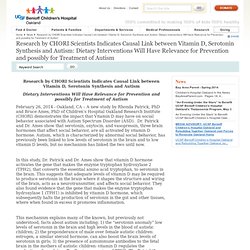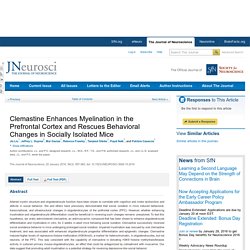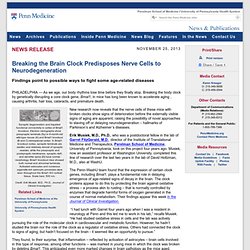

News - Link between vitamin D and dementia risk confirmed - Medical School - University of Exeter. Vitamin D deficiency is associated with a substantially increased risk of dementia and Alzheimer’s disease in older people, according to the most robust study of its kind ever conducted.

An international team, led by Dr David Llewellyn at the University of Exeter Medical School, found that study participants who were severely Vitamin D deficient were more than twice as likely to develop dementia and Alzheimer’s disease. The team studied elderly Americans who took part in the Cardiovascular Health Study. They discovered that adults in the study who were moderately deficient in vitamin D had a 53 per cent increased risk of developing dementia of any kind, and the risk increased to 125 per cent in those who were severely deficient. Similar results were recorded for Alzheimer’s disease, with the moderately deficient group 69 per cent more likely to develop this type of dementia, jumping to a 122 per cent increased risk for those severely deficient.
Stimulating brain cells stops binge drinking, animal study finds. BUFFALO, N.Y. – Researchers at the University at Buffalo have found a way to change alcohol drinking behavior in rodents, using the emerging technique of optogenetics, which uses light to stimulate neurons.

Their work could lead to powerful new ways to treat alcoholism, other addictions, and neurological and mental illnesses; it also helps explain the underlying neurochemical basis of drug addiction. The findings, published in November in Frontiers in Neuroscience, are the first to demonstrate a causal relationship between the release of dopamine in the brain and drinking behaviors of animals. Research like this, which makes it possible to map the neuronal circuits responsible for specific behaviors, is a major focus of President Obama’s Brain Research for Advancing Innovative Neurotechnologies initiative, known as BRAIN. In the experiments, rats were trained to drink alcohol in a way that mimics human binge-drinking behavior. Epigenetics and Psychoneuroimmunology: Mechanisms and Models.
MU News Bureau. Feb. 11, 2013 Story Contact(s): Timothy Wall, walltj@missouri.edu, 573-882-3346 COLUMBIA, Mo. — Parents, teachers and psychologists know boys and girls behave differently.

However, that difference isn’t taken into account by most methods used to assess the risk to children from chemical exposure, according to Cheryl Rosenfeld, associate professor of biomedical sciences in the University of Missouri’s Bond Life Sciences Center. A series of experiments by Rosenfeld studied the effects of prenatal exposure to bisphenol A (BPA) on later reproductive-associated behaviors using a socially and genetically monogamous rodent, the California mouse, which may better mirror most human societies than other rodents. She observed harmful alterations to behaviors that affect the likelihood of successfully attracting a mate and reproducing. “We use animal models to provide informative decisions about our own health and the risks associated with BPA,” Rosenfeld said.
Common flame retardant linked to social, behavioral and learning deficits. Research by CHORI Scientists Indicates Causal Link between Vitamin D, Serotonin Synthesis and Autism. Research by CHORI Scientists Indicates Causal Link between Vitamin D, Serotonin Synthesis and Autism Dietary Interventions Will Have Relevance for Prevention and possibly for Treatment of Autism February 26, 2014 - Oakland, CA – A new study by Rhonda Patrick, PhD and Bruce Ames, PhD of Children’s Hospital Oakland Research Institute (CHORI) demonstrates the impact that Vitamin D may have on social behavior associated with Autism Spectrum Disorder (ASD).

Clemastine Enhances Myelination in the Prefrontal Cortex and Rescues Behavioral Changes in Socially Isolated Mice. Jia Liu1, Jeffrey L.

Dupree2, Mar Gacias1, Rebecca Frawley1, Tamjeed Sikder1, Payal Naik1, and Patrizia Casaccia1 +Show Affiliations Author contributions: J.L. and P.C. designed research; J.L., M.G., R.F., T.S., and P.N. performed research; J.L. and J.L.D. analyzed data; J.L. and P.C. wrote the paper. Breaking the Brain Clock Predisposes Nerve Cells to Neurodegeneration. PHILADELPHIA — As we age, our body rhythms lose time before they finally stop.

Breaking the body clock by genetically disrupting a core clock gene, Bmal1, in mice has long been known to accelerate aging , causing arthritis, hair loss, cataracts, and premature death. New research now reveals that the nerve cells of these mice with broken clocks show signs of deterioration before the externally visible signs of aging are apparent, raising the possibility of novel approaches to staving off or delaying neurodegeneration – hallmarks of Parkinson’s and Alzheimer’s diseases. Epigenetics and the Human Brain. Throughout our lives, the brain remains flexible and responsive.

In addition to receiving signals from the outside world, the brain allows us to form memories and learn from our experiences. Many brain functions are accompanied at the cellular level by changes in gene expression. Epigenetic mechanisms such as histone modification and DNA methylation stabilize gene expression, which is important for long-term storage of information. Not surprisingly, epigenetic changes are also a part of brain diseases such as mental illness and addiction. Understanding the role of epigenetics in brain disease may open the door to being able to influence it. A segment from a June 2008 lecture given by Dr. Psychiatric Epigenetics.